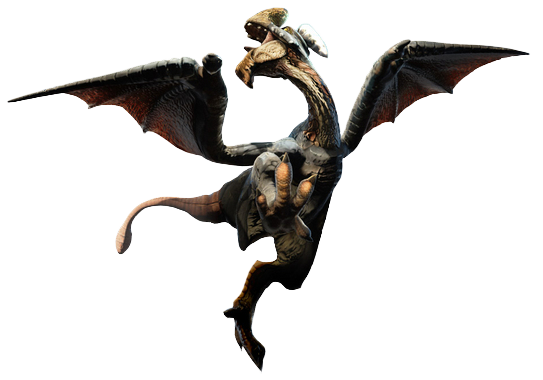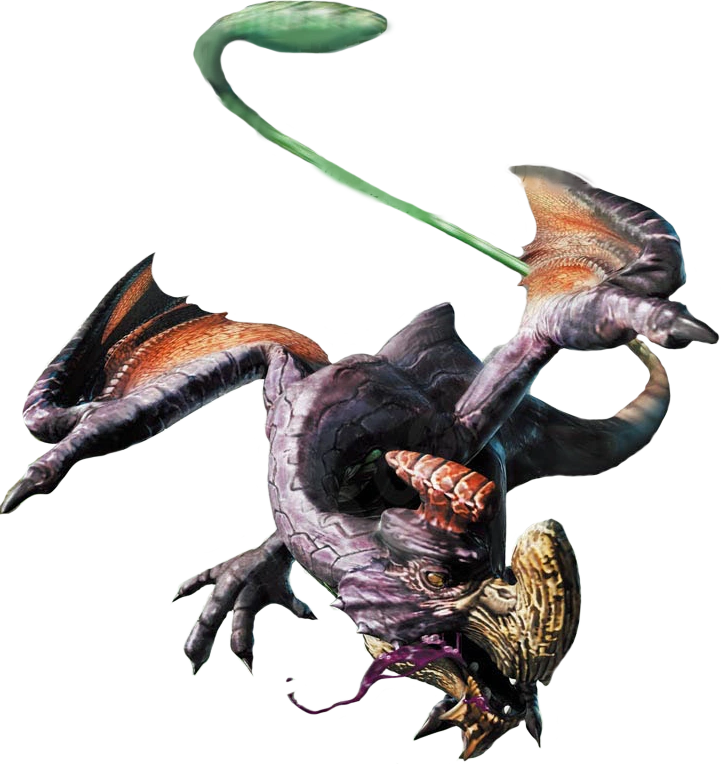 Omnivorous Bird Wyverns with scaleless stocky bodies covered in a blueish-gray rubbery hide. Their most prominent feature is the lamp-like crest atop their heads. Other unusual features include the peg-like teeth in their jaw and the shape of their beak, which extends upwards much like a nose horn. Besides that, their pink tails have a bulbous tip and can extend to whip enemies due to the elastic properties of their skin.
Omnivorous Bird Wyverns with scaleless stocky bodies covered in a blueish-gray rubbery hide. Their most prominent feature is the lamp-like crest atop their heads. Other unusual features include the peg-like teeth in their jaw and the shape of their beak, which extends upwards much like a nose horn. Besides that, their pink tails have a bulbous tip and can extend to whip enemies due to the elastic properties of their skin.Gypceros are Bird Wyverns that feed on just about anything, though they particularly favour insects like Flashbugs and Thunderbugs along with mushrooms. Hunters have reported Gypceros mistaking shiny objects in their inventory such as crystals and ores as their food, which leads to the Gypceros chasing them and stealing the items. Although they have been sighted in open fields and forests, they prefer to inhabit dark, humid areas such as swamps, marshlands and caves where their food sources are most commonly found. Their rubbery hide may be an adaptation to their diet and preferred habitats, protecting them from the electrical shocks emitted by Thunderbugs and the predatory Khezu which dwell in caves. As a consequence, Shock Traps are also ineffective on them. [Additionally, their bioluminescence may be an adaptation to living in dimly-lit areas as well.] By clapping their beak and luminous crest together, they are able to generate blinding flashes of light to disorient and blind enemies, [which may be especially effective in dark areas.] The crest is made of either ore or Lightcrystals and varies between different individuals. Being immune to their own flashes, Flash Bombs also have no effect on them. When enraged, their crest will flicker repeatedly and the patches of skin surrounding their eyes will also flush red. During the mating season, males will shine and flash their crests to attract females to their nests. They will also collect shiny objects to impress females.
Gypceros are well-known for spitting poisonous saliva from their poison sacs in self-defense. Their hides resist toxins and poisons, and it is theorized that symbiotic bacteria living on them are responsible for this. Gypceros have even developed mutually beneficial relationships with certain plants which even require Gypceros venom to grow. [These plants produce fruits that Gypceros enjoy feeding on, so Gypceros will spit their poison around them to kill off competing plants while fertilizing them. These plants also rely on Gypceros for spreading their seeds around through their droppings.]
Being the largest and heaviest Bird Wyverns known, Gypceros are sometimes considered to be Flying Wyverns. They have stubby wings and are rather poor flyers, but make up for it by having strong legs which even allows them to run on walls in certain cavernous areas. They contain Dash Extract in their bodies, which allows them to move around without expending much stamina. Despite their size, they are the favoured prey of the Temnoceran known as Nerscylla, which has been observed to feed on Gypceros trapped in their webs and skin their hides for use as a crude form of armour to protect themselves.
Being timid but intelligent, Gypceros occasionally exhibit thanatosis when confronted by threats. They play dead to fool enemies into approaching them, then thrash around to injure them. This behavior is more commonly observed when they are exhausted. Some hunters are sent back to fight the Gypceros they supposedly killed when this occurs.
 Gypceros has a subspecies known as Purple Gypceros that tends to live in hotter, more tropical environments although they can be found in all of the same habitats as normal Gypceros. [As large predatory monsters are more common in warmer areas, they have possibly evolved to produce more toxic poison to adapt.] They are also better at defending themselves, being more resilient and stronger than normal Gypceros. Their hide has a more vivid purple colour and their tails are green in colour as well, [probably serving as aposematic colouration to warn predators of their higher toxicity.] Besides that, they use their flashing attacks more frequently in battle and will chain other attacks directly into it.
Gypceros has a subspecies known as Purple Gypceros that tends to live in hotter, more tropical environments although they can be found in all of the same habitats as normal Gypceros. [As large predatory monsters are more common in warmer areas, they have possibly evolved to produce more toxic poison to adapt.] They are also better at defending themselves, being more resilient and stronger than normal Gypceros. Their hide has a more vivid purple colour and their tails are green in colour as well, [probably serving as aposematic colouration to warn predators of their higher toxicity.] Besides that, they use their flashing attacks more frequently in battle and will chain other attacks directly into it.
No comments:
Post a Comment